Heritage Trail Location 11
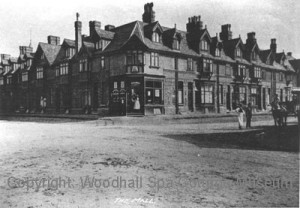
Photo 1 – The shopping mall, created by Richard Adolphus Came, on the corner of Station Road and Tattershall Road. The shop on the corner is ‘H Flower, purveyors of chocolate’. Photo courtesy of Woodhall Spa Cottage Museum
These gardens are where the Royal Hydropathic Hotel and Winter Gardens once stood.
The hotel was designed by London architect, Richard Adolphus Came, who came here in the late 19th century. He saw the possibilities for Woodhall Spa becoming a garden township and was architect to the Syndicate of gentlemen who took over the Spa in 1887. On this site, he created a quadrangular shopping mall with a crystal covered promenade, around an open space with gardens (Photo 1).
Later, Mr Came decided to build a hotel on the site. The Spa was flourishing, with more visitors arriving each year and, apart from several boarding houses, there were only two hotels in which to accommodate them.
On 8 May 1907, it was reported in the Horncastle News that the hotel had opened for visitors (Photo 2). It was said to have been “modelled in a thoroughly up to date and captivating style”. There were 120 rooms and suites and the rateable value was rumoured to be £700, which, it was said, would ease the burden on other ratepayers although it was unlikely that a businessman such as Mr Came would accept this figure without an appeal.
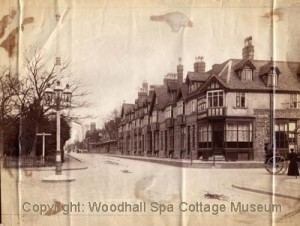
Photo 2 – The Royal Hydro Hotel and Winter Gardens, not long after opening in 1907, looking down Station Road. Note the sewer stench pipe to the left of the picture, with street lights attached. Photo courtesy of Woodhall Spa Cottage Museum
A week after opening, the Royal Hydro was included in the newspaper’s Visitors List for the Spa and 6 people were staying there. A Select dance was reported to have been held, with “most of the best known residents of the Spa and their friends attending”. At the end of the month Mr Came applied for a licence to perform stage plays in the Winter Gardens, pointing out that fire precautions included 4 hydrants and that as well as the large main entrance into the room, there were 12 exits which could be used in an emergency
At the beginning of September, two titled ladies, Lady Louisa Wells and the Dowager Duchess of Warwick, were among the 40 or so guests staying at the hotel, one of whom was the popular novelist of the late 19th century, Miss Marie Corelli. The 1907 Woodhall Spa Season ended on 11 September. It seems to have been highly successful for the Royal Hydropathic Hotel and Winter Gardens.
Mr Came did not close his hotel for the winter and over the years it became greatly in demand for local functions. There were dances and concerts to raise money for clubs and charities or the Alexandra Hospital. End of year Prize Givings for Miss Lunn’s High School for Girls, on the Broadway, were held there; Smoking Concerts were enjoyed by the Cricket Club and the Golf Club held its annual Fancy Dress Ball in the Winter Gardens each January.
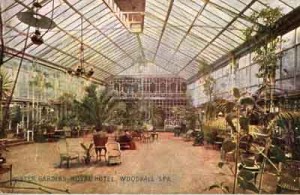
Photo 3 – The Winter Gardens, taken from the stage. (Postcard from Webmaster's collection).
At this time, there was a constant search for new springs of Spa water in the village and in February 1905, Mr Came located one off Tattershall Road, not far from the Roman Catholic Church. A 7 feet diameter shaft was sunk and water was found at 492 feet. Several interesting fossils were reported as having been found in the shaft, including an ammonite with a diameter of 2 feet. This water, when analysed, was found to contain all the minerals of Spa water, with Epsom salts in addition. As a result of this successful boring, Mr Came decided to build a Bath House next to his hotel. Unlike the Spa Baths, his would remain open in the winter.
By November 1906, the Baths were complete and an advertisement appeared in the paper of the 24th of the month, to the effect that they were open for villagers to use on 3 days each week. Mrs Edith Bagshaw was Manageress at this time. In 1907, we read that she owned a terrier, which sadly was killed, when chasing a train along the railway line behind the hotel.
The hotel had regular entertainments and sometimes artists were brought from London. At a local level, we read that on a Saturday afternoon in July 1907, Mr Allen, the band leader, gave a concert for patients at the Alexandra Hospital who greatly enjoyed the fine string band and also Mr Allen’s spirited whistling solos. In August 1907 there were 55 visitors staying in the Royal Hydro, compared with 40 at the Eagle and 95 at the larger and grander Victoria.
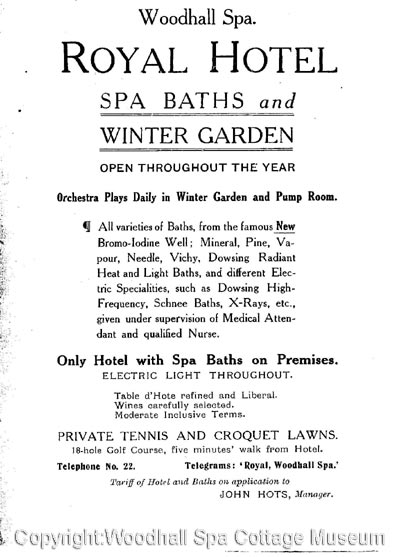
Figure 1 – Advert for the Royal Hydro Hotel and Winter Gardens taken from a souvenir booklet of 1911. (Photo courtesy of Woodhall Spa Cottage Museum).
An advertisement in a souvenir booklet in 1911 shows that the hotel was well established (Fig 1). The name of the Medical attendant is not given, but Dr Gwyn, who lived on Horncastle Road, was Medical Superintendent of the Royal Hydro Baths for some time. He died in 1922. A lady named Adeline Pacey, who was born in 1904, recorded that she remembered seeing Bath attendants in red dresses through an open door, when she was a girl.
Mr Came had a flat in his hotel, situated at the end, next to what is now the Mall car park. At the other end, on Tattershall Road, there was a ladies’ hair dressing establishment, at one time occupied by Miss Hattie Rose, then Miss Phyllis Gresham and later Mrs Duffy. Mr Leslie Chapman and his wife lived in a flat overlooking Station Road, when they were married in 1932. Miss Rose, a niece of the bakers at Kirkstead, lived underneath. They were great friends and she allowed them to go downstairs for baths. Later, Mr Chapman remembers Mr Oyler, who was the manager of Abbey Lodge, lived in that flat.
Famous visitors included Dame Nellie Melba, the Australian singer, after whom the dessert “Peach Melba” is reputedly named, when she was a guest of the Weigalls at Petwood House.
The hotel was closed at the outbreak of war in 1914. On 1 April 1915, the newspaper reported “the worst blizzard remembered” when trees were uprooted, trains delayed and property damaged, in the Spa. Two large chimneys were blown off the Royal Hydro Hotel.
In 1918, every effort was made to return to the life before the war, but the Spa did not really recover and by 1920, the Royal Hydro was virtually empty. However, it continued to be a popular venue for dances and every type of village function. Mr Scott Targett became Manager of the hotel in 1936. He was a Methodist and a teetotaller and so he stopped the sale of alcohol. Previously, there had been a popular bar. He introduced a Boxing Ring and invited champions from places as far away as Manchester. Both local people and many from further afield, such as Boston and Cranwell came to watch. He also ran a Table Tennis Club for young men and invited the National Champion to give an exhibition.
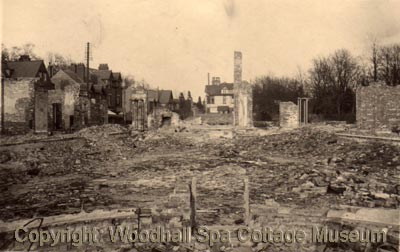
Photo 4 – The site of the Royal Hydro Hotel, not long after the bomb fell. (Photo courtesy of Woodhall Spa Cottage Museum).
Mr Targett continued the tradition of engaging well known artists and Paul Robeson, the famous bass singer, is still remembered as coming to Woodhall Spa. During the early years of the Second World War, Ivy Benson’s Ladies’ Band made a popular visit.
The army requisitioned the hotel in 1940. They concreted over the beautiful dance floor and gun carriers ploughed up the car park. Mr Targett returned to London in 1941, leaving Mr Brookman in charge.
Then came disaster. On the night of 17 August 1943, two German parachute retard bombs were dropped over Woodhall Spa, one of which hit the Royal Hydro Hotel. Fortunately, none of the many soldiers stationed in the hotel was hurt, as they were away on manoeuvres that night, but the building was badly damaged. Some of the brickwork survived, but the roof was missing, doors were blown out, window frames were useless and there was glass everywhere (Photo 4).
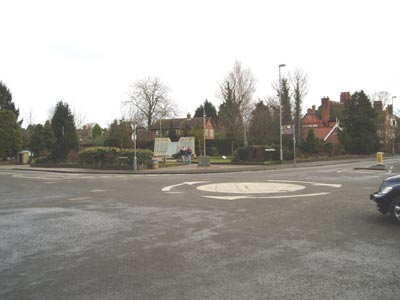
Photo 5 – The Royal Square Gardens, in late 2005 (viewed from the same position as Photo 1), with the Dambuster Memorial at the rear of the gardens. (Photo courtesy of Woodhall Spa Cottage Museum).
The next day was spent clearing the site and sweeping up glass. It was decided that it would be too expensive to rebuild the hotel and eventually it was dismantled and the debris carried away. Mrs. Joyce Dowse remembered carting stone away on a tractor for a local builder at 1 shilling (5p) per load.
A beer garden was suggested as a replacement, but Mr Targett was certainly not having that! In the end it was decided to give the piece of land on which the hotel had stood to the Urban District Council as a memorial to the village.
The Royal Hydropathic Hotel and Winter Gardens is still remembered fondly by older residents of the village. Mr Peter Wilson recalls it well and comments, nostalgically, that his bungalow was built on what had been the pretty gardens of this lovely hotel. The Royal Square Gardens (Photo 5), a public car park and the car park of The Mall Public House now occupy the site of the Royal Hydro Hotel and Winter Gardens.
Heritage Trail locations
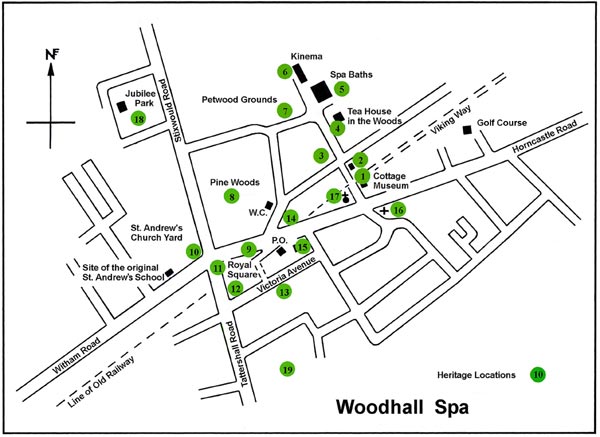
The trail can be started at any location, but we suggest you also visit the Cottage Museum to see the photographs taken by John Wield during the heyday of the Spa and items associated with this unique Victorian Spa town.
The Trail is just one of several projects in the hands of the Woodhall Spa Parish Council sponsored Heritage Committee. Click here if you are interested in the committee or their projects.
How well do you know Woodhall Spa?
See if you can identify the location of these architectural features and items of street furniture! Or find the Letterbox (coming soon).
Find out more about the Woodhall Spa Conservation Area